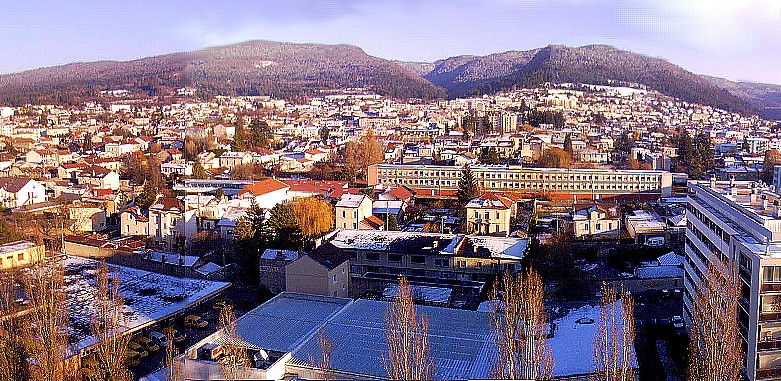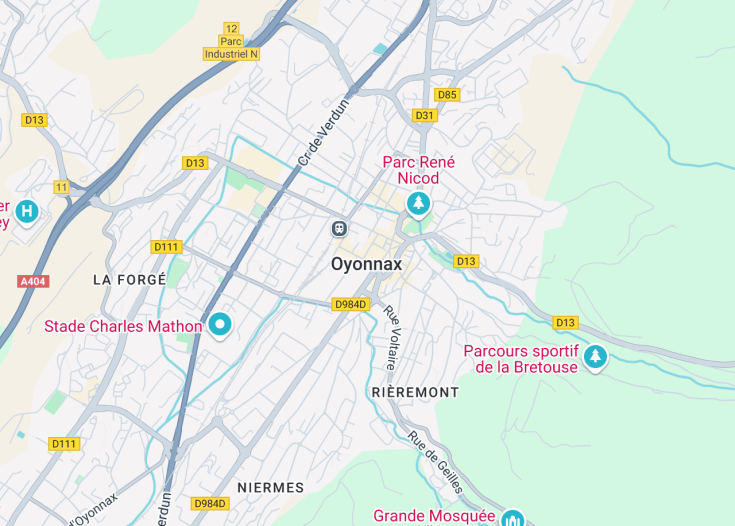Nestled in the picturesque Haut-Bugey region of Ain, France, Oyonnax stands out as a unique blend of industrial heritage and natural beauty. Renowned primarily for its pivotal role in the plastics industry, the city offers visitors a fascinating glimpse into French technological history while being surrounded by dense, inviting forests ideal for outdoor pursuits. The city’s vibrant cultural scene, enriched by museums and seasonal festivals, makes it an intriguing destination for those keen on exploring the less-trodden paths of France.
Don’t miss a visit to the Musée du Peigne et de la Plasturgie, where you can delve into the innovative heart of Oyonnax’s plastic and comb-making industries.
For a touch of nature, plan a hike through the nearby Risoux forest, an ideal spot for those looking to enjoy serene landscapes and diverse wildlife.
Top things to do & see in Oyonnax
Select the following sights and activities to discover best tickets and tours available in Oyonnax.
Oyonnax: The Hidden Gem of France
| Country | France |
| Time in Oyonnax | GMT+1 |
| Language spoken | French |
| Population | 22,678 (source: latest municipal data) |
| Currency | Euro (€, EUR) |
| Airports |
|
Oyonnax, located in the heart of the Haut-Jura in eastern France, is a town known for its significant role in the plastics processing industry dating back to the 19th century. Nestled in a valley surrounded by mountains, Oyonnax might not be the first name that comes to mind for typical French tourism, but its unique economy and picturesque environment make it an intriguing place for both economic and environmental historians.
Oyonnax’s transformation began in the 1700s when comb manufacturing set the stage for the introduction of plastic manufacturing, which today remains a cornerstone of its economy. The city’s deep involvement in plastics has even earned it the moniker ‘Plastics Valley’. The town’s innovative approach towards this versatile material is evident in the Oyonnax Plastic Valley expo, which attracts professionals and enthusiasts from around the world.
Despite its industrial influence, Oyonnax prides itself on beautiful landscapes, providing outdoor enthusiasts with a multitude of activities ranging from hiking and biking in the summer to cross-country skiing in the winter. The town is a gateway to the Haut-Jura Regional Natural Park, a protected area featuring rich biodiversity and stunning geological features like limestone cliffs and deep valleys.
The local population and government are conscious of their environmental responsibilities, focusing on sustainable practices around their industry which attracts a consistent number of eco-conscious visitors each year. Moreover, the diverse cultural heritage of Oyonnax, influenced by the adjacent regions like Switzerland, adds an interesting melange of cultural events and cuisines to the already rich French culinary tradition present here.
In Oyonnax, one can witness the harmonious blend of industry and nature, a testament to the town’s resilience and innovative spirit. The town’s cultural scene is vibrant with festivals such as the Plastics Arts Festival and the Musical Spring of Oyonnax, featuring live music events that showcase both local and international talent, echoing the communal spaces of the town squares and cozy cafes that dot the landscape.
Where is Oyonnax?
Positioned in the Auvergne-Rhône-Alpes region of eastern France, Oyonnax is dramatically nestled between the Jura mountains and vast expanses of forest.
Distances:
| Route | Distance by car | Time by car |
| Paris to Oyonnax | 298 miles | 4 hrs 50 mins |
| Lyon to Oyonnax | 74 miles | 1 hr 20 mins |
What is Oyonnax famous for?
Oyonnax is notably famous for its vibrant plastics industry, which has led to its nickname ‘Plastics Valley’. The town also hosts various cultural and music festivals that are significantly recognized on a regional scale.
History
Pre-History to Middle Ages
The area now known as Oyonnax was inhabited since prehistoric times, as evidenced by archaeological discoveries in the region. The early settlers were primarily engaged in agriculture and hunting. Over the centuries, the region saw gradual development. By the Middle Ages, a small community had formed, centered around the burgeoning forestry and agriculture industries.
16th Century to French Revolution
The development of Oyonnax as a town truly began in the 16th century when its strategic location on trade routes contributed to its growth. The town’s proximity to natural resources like timber and later, the advent of water-powered mills, helped develop a blossoming local industry. The period leading up to the French Revolution saw Oyonnax becoming increasingly self-sufficient, although it was not immune to the wider socio-political upheavals of France.
19th Century to Early 20th Century
The 19th century marked a significant turn for Oyonnax with the industrial revolution. The town became a hub for the plastics industry, leveraging its abundant natural resources and water power to develop celluloid production. This era significantly shaped its economic landscape, making it a center of innovation in the plastics industry, which earned it the nickname “Plastics Valley.”
World War II
Oyonnax played a notable role during World War II as a center of resistance against the Nazi occupation. The town is famously known for the “Oyonnax wreath,” a symbol of resistance laid in 1943 to honor fallen French soldiers, which was a significant act of defiance against the Nazis.
Late 20th Century to Present
In the post-war period, Oyonnax continued to thrive economically, bolstered by its established plastic industry. The late 20th century and the turn of the millennium saw diversification in its economic activities with advancements in technology and a shift towards more sustainable practices. Today, Oyonnax remains a vital industrial town with a rich historical heritage, blending its historical roots with modernity.
Visit Oyonnax
What to see and do in Oyonnax, France
Visitors to Oyonnax can enjoy a variety of attractions and activities that highlight both its natural beauty and its unique industrial heritage. A must-see is the Museum of Combs and Plastics, which details the town’s pivotal role in the plastics industry. For nature enthusiasts, the nearby Haut-Jura Regional Natural Park offers extensive hiking, cycling, and cross-country skiing trails set in picturesque landscapes. Oyonnax is also home to charming boutiques and local eateries where visitors can explore local crafts and savor regional dishes.
- Explore the Museum of Combs and Plastics
- Visit Haut-Jura Regional Natural Park
- Enjoy local cuisine and shopping
Festivals and Events in Oyonnax
Oyonnax hosts several cultural and recreational events throughout the year, reflecting its rich heritage and community spirit. Notable events include the Plastic Arts Festival, typically held in the fall, which celebrates the town’s historical connection to the plastics industry with exhibitions, workshops, and lectures. The summer months often feature outdoor concerts and community gatherings in the scenic locales around the town.
Best time to visit Oyonnax
The best time to visit Oyonnax is during the spring and summer months, from April to September, when the weather is most favorable for outdoor activities and exploring the surrounding natural beauty. Additionally, many of the town’s events and festivals take place during this period, offering visitors a richer cultural experience.
Is Oyonnax worth visiting?
Oyonnax offers a compelling blend of history, culture, and natural beauty, making it a worthwhile destination for those interested in industrial heritage or outdoor adventures. However, it might not cater as well to those seeking bustling city life or extensive nightlife options. The town’s relatively remote location and focus on industrial tourism can limit some visitors but provide a deep and engaging experience for others, particularly those fascinated by history or seeking peaceful natural retreats.









